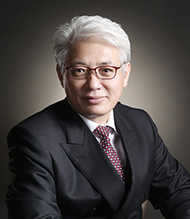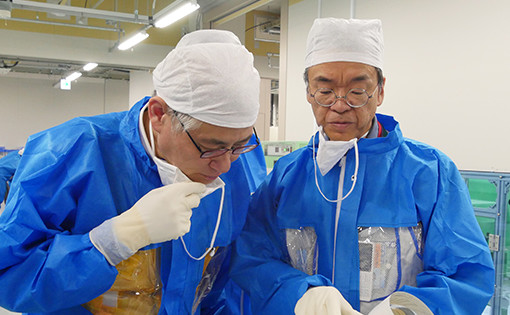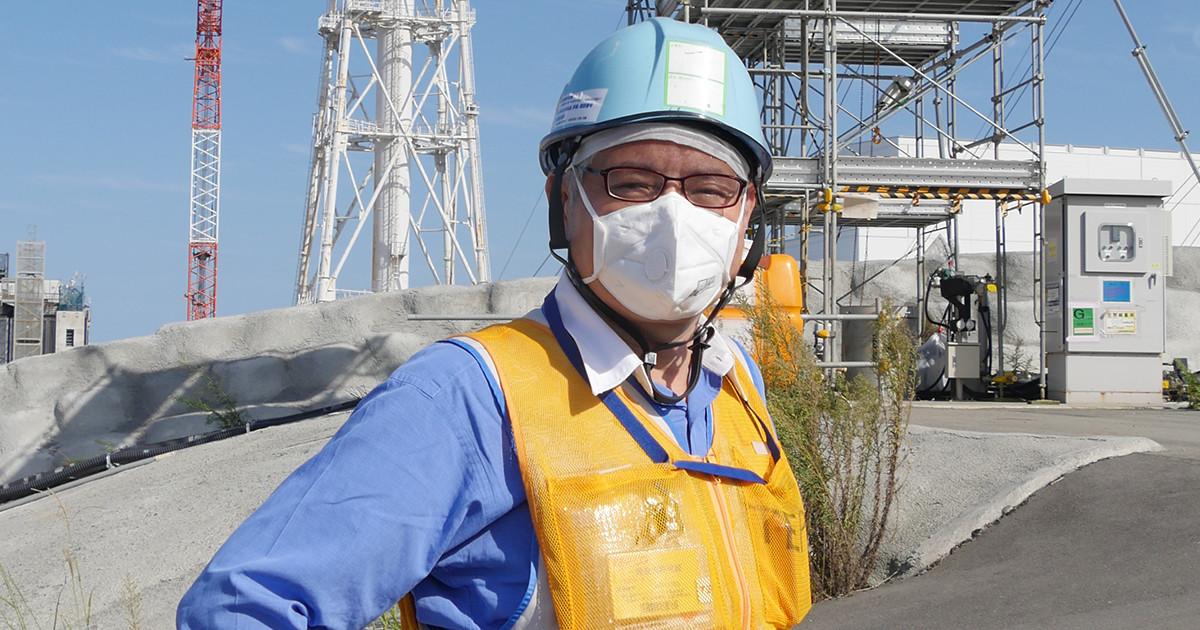Fukushima Daiichi
Nuclear Power Plant in 2017
Minimizing the Negative Impact
Upon entering the nuclear power plant, I received an orientation for visitors. In other words, I watched a video, and they spoke about the changes at Fukushima Daiichi Nuclear Power Plant over the past six years.
After that, I toured and covered 10 different locations, but I was surprised by the strict and intelligent methods used to restrict access to the nuclear power plant’s control facilities. First, we spent 30 minutes touring the chemical analysis building.
Here analysts diligently track the daily chemical changes in this place. We observed the Advanced Liquid Processing System, a high-tech facility of which there are only a few in Japan. Next, we drove to the low rise where Reactor 3 is located. I saw the exteriors of Reactors 1-4 so familiar to the public.
On the buildings, I saw a blue sign reading “March 11th, 2011, 17 meters,” which indicated the tsunami that followed the earthquake on March 11. It was, in fact, a mark of the tsunami that struck at that time.
Next, we observed the landward and seaward water retaining walls made from frozen soil. Their main function is to prevent the outflow of contaminated water. After that, we observed the emergency diesel generators and waste treatment plant near Units 5 and 6.
However, I cannot say that they have been fully restored. I can still see today the awful scene from that time when the tsunami struck in the aftermath of the earthquake. Three tanks and Reactors 1-4 were knocked askew and twisted by the impact of the tsunami.
Moreover, the image of the tops of the buildings broken or burned in the earthquake still persists in my mind, both painful and terrifying to recall.
The Fukushima Daiichi staff gave a detailed briefing on the status of Reactors 1-4.
They went over the ongoing cold shutdown status of all reactors, the processing of contaminated water, the use of a 1,500-meter (.93-mile) landward water retaining wall made from 70,000 cubic meters of frozen soil, and improvements to the working environment, as well as the lack of the need for workers to wear protective clothing in 95% of the areas inside of the nuclear power plant, and the future schedule for removing the nuclear fuel debris.
“Did a large amount of contaminated water flow into the ocean due to the Fukushima Daiichi leak after the earthquake?”
I asked. “Yes, something like that did occur,” they responded.
I asked if the outflow of contaminated water had an impact on marine products in the surrounding area, and they answered, “We cannot deny that there was a negative impact.”
Then I asked, “Is there still a negative impact from the radioactive contamination today? How are you working to mitigate this impact?”
They responded, “We are working constantly to use the latest technologies to control and minimize the negative impacts of radiation.
Currently, Fukushima Daiichi Nuclear Power Plant is dealing with the issues of safety and peace of mind. What we can and must continue to do is work to maintain safety. In order to provide peace of mind for local residents, Japan, and the world, there is still much long-term effort required in a wide variety of fields.”
Shinzo Abe’s “Trump Card”
When I ask if Prime Minister Shinzo Abe has ever visited Fukushima Daiichi power plant, they reply, “Coincidentally, the day you came here to do this story is September 19th.
Prime Minister Abe came to see the nuclear power plant on this same day four years ago.”
As far as I know, Shinzo Abe assumed the post of prime minister in December 2012. That was his second time he became prime minister.
Since then, the prime minister has visited the three prefectures in the Tohoku disaster area numerous times.
He has visited Iwate Prefecture eight times, Miyagi Prefecture 12 times, and Fukushima Prefecture most of all at 16 times, as of this writing. But he has only visited Fukushima Daiichi twice.
In early August, 2017, Shinzo Abe reshuffled his Cabinet to shore up his plummeting approval rating. At the first Reconstruction Promotion Council held after the shakeup, the prime minister stated, “In this Cabinet, there must be a shared awareness that all Cabinet members are reconstruction ministers.”
The prime minister knew that with the passage of time, some members of the Cabinet had become out of touch and indifferent to recovery efforts.
At the moment, Fukushima Daiichi has three problems.
1. The accumulated contaminated soil is an issue. The Great East Japan Earthquake caused a tank breach at Fukushima Daiichi Nuclear Power Plant, resulting in soil contamination over a wide area.
Afterward, TEPCO Fukushima Daiichi undertook decontamination measures expected to be highly effective, and the amount of contaminated soil removed totaled 14 million cubic meters. However, only 370,000 cubic meters of contaminated soil have been securely stored since then, accounting for just 3 percent of the total amount. The remainder is still covered in green plastic sheeting or stored in black bags.
The Japanese government has said that all of the contaminated soil will be taken away by 2020, but is this actually possible?
2. Keeping the contaminated water completely under control is difficult. Over the six and a half years between the Great East Japan Earthquake of 2011 and today, the amount of contaminated water seeping into the ground has continually increased, and Fukushima Daiichi acknowledges that this amount has already exceeded 1 million tons.
Even if one were to say “The outflow of this amount of contaminated water into the sea is equivalent to tossing a handful of salt into the ocean, so it will not cause serious contamination,”
there is not likely to be anyone free of concerns about this kind of salt.
3. Recovery of fuel debris from Reactors 1-4. While they have used all sorts of methods so far, such as using robots for exploration, information on the melting and dispersal of fuel debris inside the reactor remains sketchy. According to the schedule, retrieval will commence by 2021, and will complete sometime between 2041 and 2051.
There still remain “difficult-to-return zones” in Fukushima Prefecture to this day, and there are still some 57,538 people, mainly in Fukushima Prefecture, who are living as refugees.
Prime Minister Shinzo Abe has proposed a “Fukushima Innovation Coast Framework,” and has dubbed it his “Fukushima recovery trump card.” Abe has said that Fukushima Daiichi Nuclear Power Plant will be “used as a hub for research on decommissioned reactors and applied robotics” in order to “show the world the evolution of Japan’s nuclear energy technology in the face of challenges.”
Having written this far, I recalled one particular episode during my coverage. Daisuke Hirose, who is second in command of TEPCO’s media relations group, said, “We now have five ways of pumping water into Reactor 1.
When the earthquake struck in March 2011, we were desperately trying to pump water into Reactor 1 to cool it down.
I remember that Sany Heavy Industry of China came to our assistance with a large pump truck, and saved us from a lot of serious trouble. We will never forget the help we received from China.”

Writer Jiang Feng
Born in Beijing, China, Jiang serves as Editor-in-Chief of the People's Daily Overseas Edition Japan Monthly and the Tokyo branch of Orient Publishing Center, as well as special Japan-based reporter for the Global Times. His Sina blog, Jiang Feng’s Blog, which covers Sino-Japanese relations and other topics, has been accessed approximately 140 million times, and his microblog, Jiang Feng’s Sina Weibo, has around 900,000 followers. In 2013, he was selected as Most Valuable Columnist in the Sina Network and is known as “the leading authority for showing Japan to China.”




